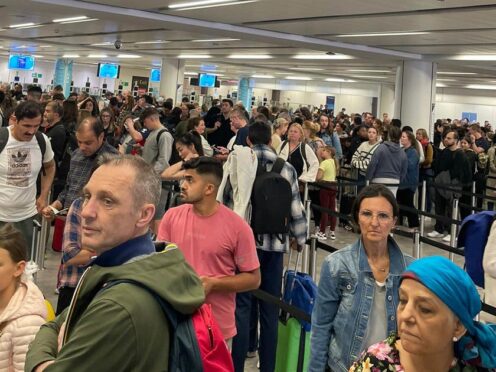A minister has apologised to passengers after a fault with Border Force passport e-gates caused widespread disruption at airports across the UK.
Travellers faced long queues on Tuesday night at airports including Heathrow, Gatwick, Edinburgh, Birmingham, Bristol, Newcastle and Manchester because of the “technical issue” which lasted several hours.
E-gates, automated border gates, use facial recognition to check the identity of a person in order to let them enter the UK without talking to a Border Force officer.
There are more than 270 e-gates at 15 airports and railway stations across the country, according to the Government’s website.

Because of the outage, Border officials had to manually process travellers instead, with images and footage circulating online showing long queues forming at passport control at several airports.
Speaking in the Commons on Wednesday, Tom Pursglove said an investigation had determined the incident was caused by “technical issues within the Home Office network.”
There was no indication of “malicious cyber activity” behind the fault, the minister for legal migration and the border told MPs.
Engineers detected a wider system network problem at 7.44pm on Tuesday and e-gates at UK airports came “back online” shortly after midnight on Wednesday, according to the Home Office.
Mr Pursglove said: “I sincerely apologise for the disruption that occurred. I can assure the House that the Home Secretary and I will be unswerving in our determination to ensure that every possible lesson is learned, to ensure that this does not happen again.”
Describing how teams “quickly swung into action”, Mr Pursglove said the fault was responded to “within six minutes”, and once the fault was identified, “officials worked closely with partners to rectify the problem and restore service”.
Security checks were “maintained throughout”, he said, adding: “Border security was not compromised at any point and there is no indication of malicious cyber activity. Police access to operational systems was unaffected.”
Footage obtained by the PA news agency shows long queues as passengers waited to go through passport control at Heathrow. Some can be heard clapping and cheering as the problem was resolved and queues started to move.
Sam Morter, 32, who arrived at Heathrow from Sri Lanka, said it was “pandemonium” when he got to passport control in Terminal 3, where all of the e-gates had blank screens, telling PA: “There was a lot of Border Force officials running and scrambling around. Four or five went to man the posts and start processing the UK passports manually.
“But at the same time, hundreds of passengers started to flood into passport control, so it all of a sudden became chaotic and they couldn’t cope with the number of the people coming in.”
Mark Ford said he waited over two hours to get through border security at Heathrow while returning home from Barcelona with his wife.
The 49-year-old IT consultant, from Worthing in West Sussex, said they were told to join a queue “which by this point stretched all the way down one corridor, round the corner to the end and then back on itself”.
Footage filmed by Mr Ford shows some people shaking their heads in frustration while waiting in a long queue as an announcement is made which explained there was a “system outage” and, at that point, there was “no timeframe” on how long it would take to fix.
“It was frustrating, but I work in IT so I know these things can happen.
“I think if it had gone on much longer I would have had a sense of humour failure,” he said.
Paul Curievici, 41, from Haslemere in Surrey, landed at Gatwick Airport at about 7.30pm on a flight from Lyon and waited in line for almost an hour at passport control.
He said: “(I was) a little bit resigned at what initially looked like another British infrastructure failing, and (I had) quite a lot of sympathy for the poor buggers furrowing their brows and trying not to look embarrassed.”
Labour’s shadow Home Office minister Dan Jarvis joined Mr Pursglove in paying tribute to “passengers who waited patiently for many hours, some of them after very long flights” but said the e-gate system is “no longer reliable enough.”
He told the Commons: “I’m sure that the House will agree that the chaotic scenes across many of the UK major airports last night are unacceptable.
“Not least, given e-gates have failed on several occasions in recent years.
“That is unacceptable and it brings into sharp focus how the current high capacity e-gates system is no longer reliable enough and risks further damaging public trust in the Government’s management of our border security.”
The response of Border Force was evidence that “overall the contingency plans did work”, Mr Pursglove said, adding that there was a “permanent fix” for the specific technical issue that caused the fault, as he insisted this was an “extremely rare occurrence”.
